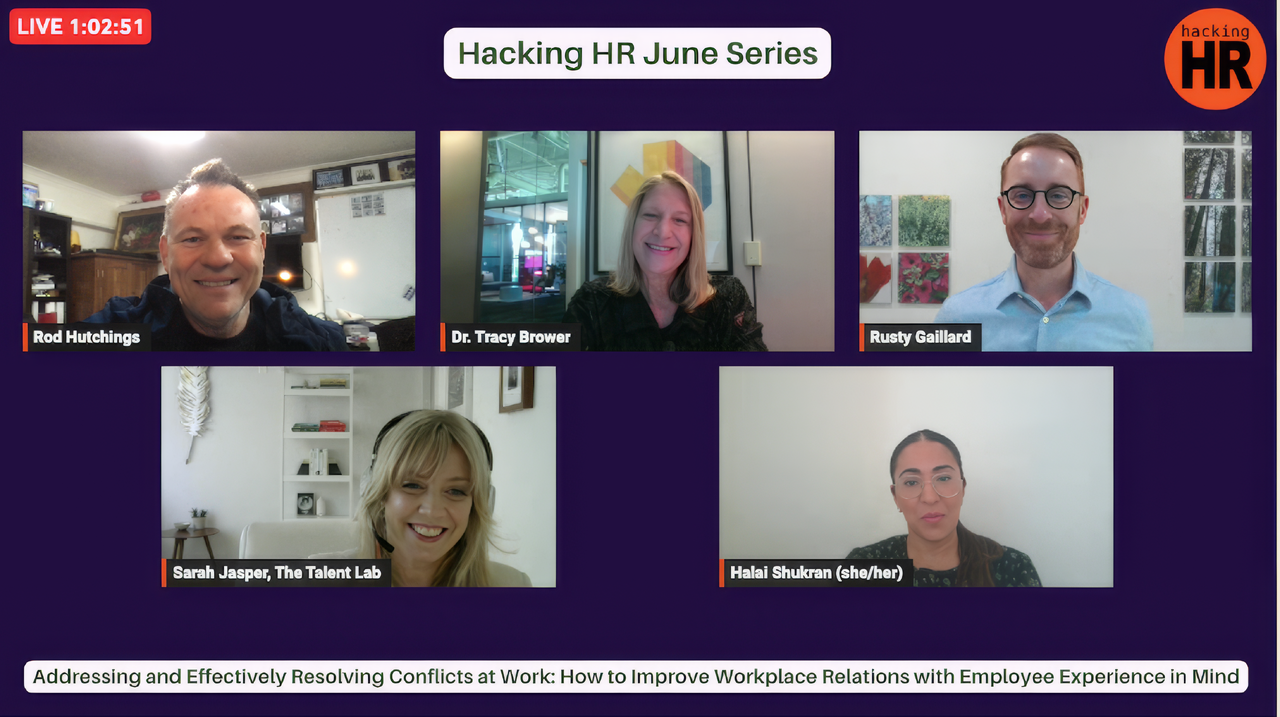Introduction

Conflict in the workplace is often viewed as a negative force, but a recent Hacking HR panel discussion revealed a different perspective. The conversation, featuring experts like Dr. Tracy Brower, PhD, Rusty Gaillard, Sarah Jasper, and Halai Shukran, SPHR, focused on the importance of addressing conflicts constructively, prioritizing the employee experience, and fostering healthy, constructive dialogue. This article delves into the insights shared during the panel and outlines practical strategies for leaders to turn conflicts into opportunities for growth and innovation.

The Benefits of Conflict
The panel began by emphasizing the potential benefits of conflict. Tracy Brower, PhD, author of “The Secrets to Happiness at Work,” highlighted that constructive disagreement can lead to innovation and improved team dynamics. Rusty Gaillard, an executive coach and author, shared his experience working with leaders to enhance their conflict resolution skills, stressing that avoiding conflict can negatively impact employee experience and performance.

Creating a Safe and Inclusive Environment
A central theme of the discussion was the need to create an environment where diverse perspectives can be shared without fear of retribution. Sarah Jasper, founder of Talent Lab, explained that conflict is a natural part of human collaboration and critical for modern workplaces. Despite efforts to promote positivity, conflict is on the rise, and civility is declining. Rusty added that intentional encouragement of healthy conflict can foster psychological safety and constructive feedback.

Practical Tips for Leaders
The panellists provided several actionable recommendations for leaders to manage conflicts effectively:
- Recognize Ideas, Not Just Accomplishments: Leaders should acknowledge individuals for bringing ideas to meetings. This encourages a culture of innovation and open dialogue.
- Encourage Disagreement: Instead of asking, “Does everybody agree?” leaders should ask, “Does anybody disagree?” This invites diverse viewpoints and reduces the pressure to conform.
- Provide Training for Self-Awareness and Courageous Conversations: Developing these skills helps employees navigate conflicts constructively and fosters a collaborative environment.
- Focus on Inclusive Language and Behaviors: Leaders can create a safe space for conflict by focusing on behaviours rather than personalities. Encouraging self-awareness and ownership can break down barriers and enhance collaboration.
Handling Conflict in Remote and Hybrid Work Environments
The panel also addressed the unique challenges of remote and hybrid work settings. Halai Shukran highlighted the difficulties in encouraging healthy conflict and psychological safety in remote environments. Sarah Jasper suggested that open forum dialogues might not be the best way to hear all voices, especially from introverted individuals. She recommended creating alternative settings where team members can reflect and share their thoughts.
Rod Hutchings related this idea to his son, who benefits from having time to think through his thoughts before sharing them. This highlights the importance of considering individual communication styles in remote work setups.
Leadership Styles and Encouraging Participation
Effective leadership is crucial for fostering collaboration and open communication. Rusty Gordon emphasized the importance of leader humility, participation, and support for diverse ideas. Leaders should consider the connection dimension (asynchronous vs. in-person) and the breadth (number of people in the room) when designing interactions to elicit the best ideas from their teams.
Strategies for Psychological Safety and Trust
Tracy Brower underscored the importance of dialogue and debate in a culture that values healthy disagreement. Leaders can facilitate better team decision-making by being clear about the conversation’s purpose beforehand and actively seeking input and disagreement during meetings. Reward programs and recognition can support ongoing initiatives but may falter in acknowledging unconventional or innovative ideas.
Halai Shukran appreciated idea generation and acknowledged individuals for bringing their ideas to the table, fostering a collaborative environment. Tracy Brower noted that a mix of red, yellow, and green feedback signals psychological safety and trust within a team.

Empowering Teams and Embracing Failure
Sarah Jasper suggested rewarding inquiry and asking questions in meetings to encourage different perspectives and ownership. Rusty Gordon agreed and added that overemphasizing opinions can stifle someone else’s creativity and ownership. Empowering team members and celebrating their successes is vital for fostering an inclusive and innovative workplace.
I shared Roger Federer’s graduation speech, emphasizing the importance of moving past mistakes and maintaining a positive attitude. This message resonates with the need to embrace failure as a learning opportunity and support team members in their growth.
Conclusion
The Hacking HR panel discussion shed light on the importance of addressing conflicts constructively and prioritizing the employee experience. By creating a safe and inclusive environment, encouraging open dialogue, and providing practical training, leaders can turn conflicts into opportunities for growth and innovation. Embracing conflict as a natural part of collaboration and leveraging diverse perspectives can enhance team dynamics, trust, and overall performance. As the panellists highlighted, investing in these strategies is essential for building a resilient and innovative workplace.